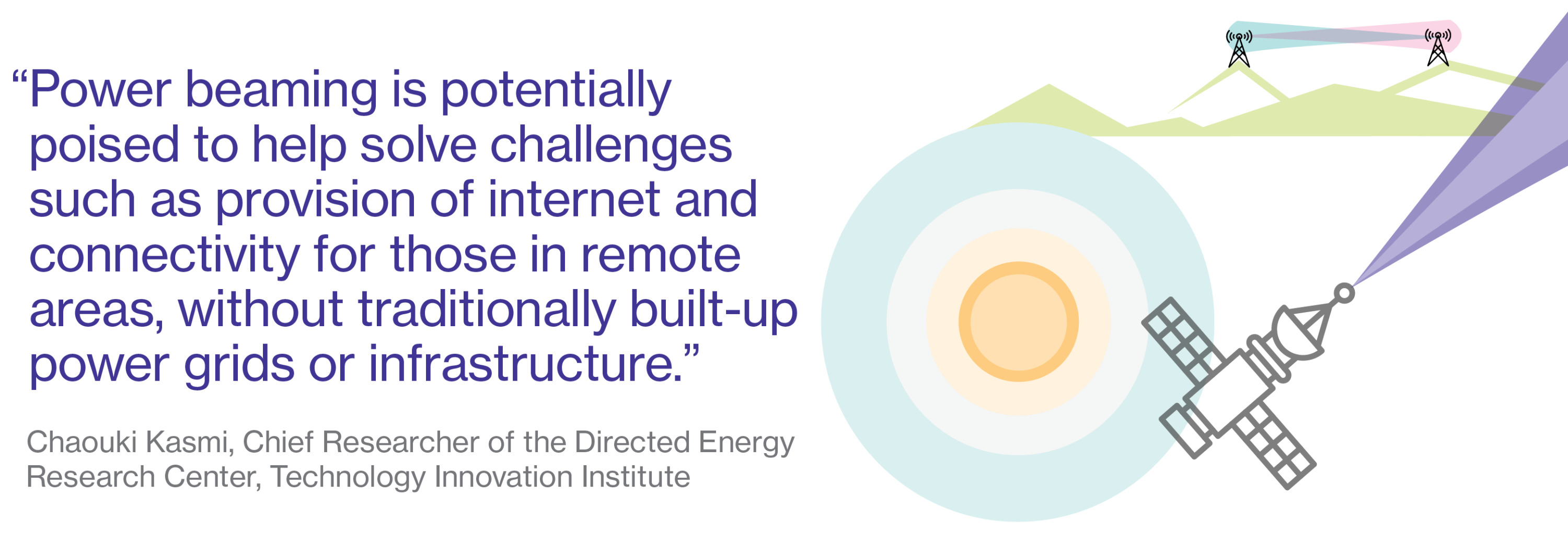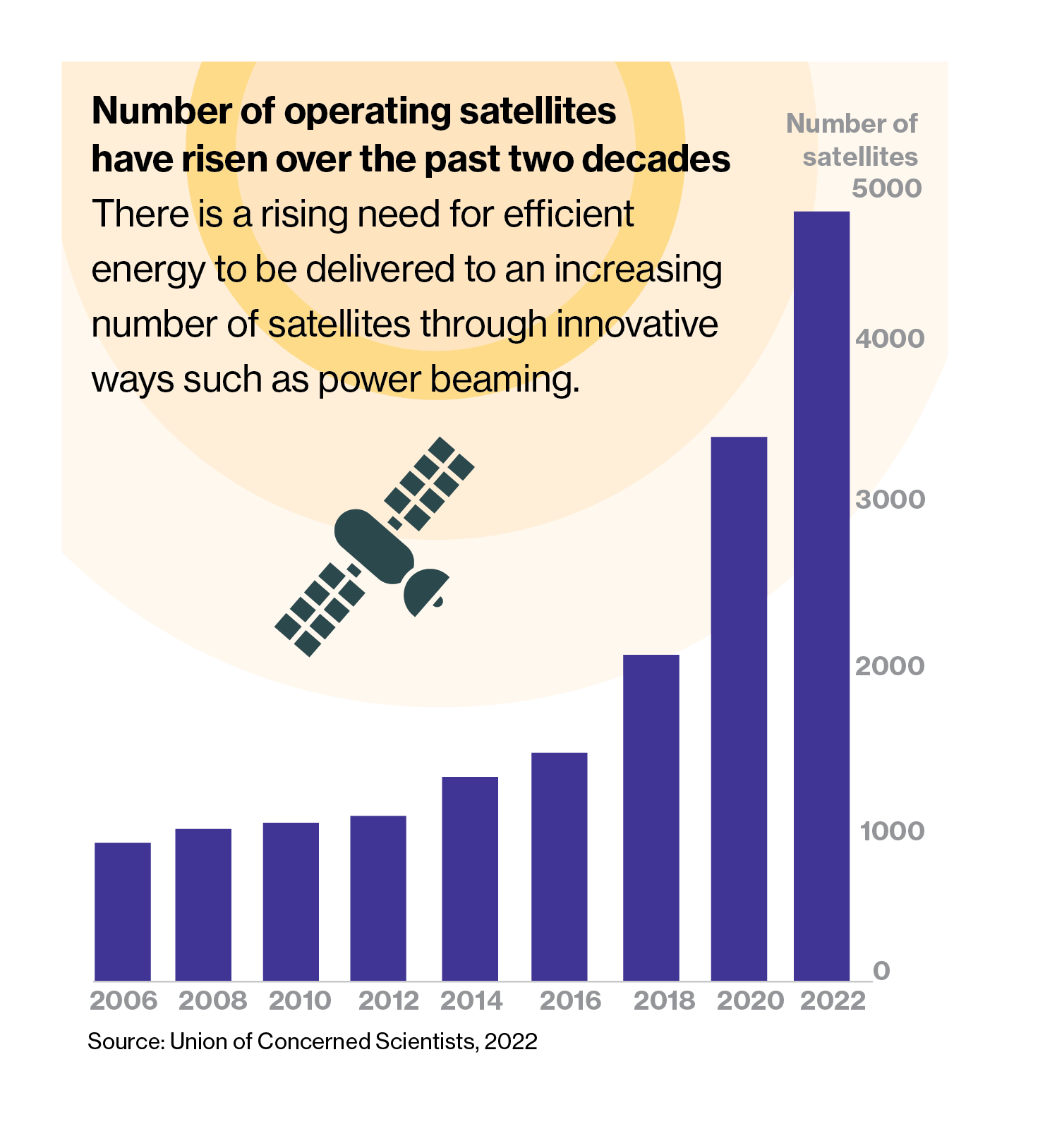Sponsored
Power beaming comes of age
How power beaming could change the way we power everything from satellites to mobile phones and reduce carbon emissions.
In association withTechnology Innovation Institute
Power beaming has long been a dream of engineers and innovators. Defined as the point-to-point transfer of electrical energy by a directed electromagnetic beam, the idea originated from Serbian-American physicist Nikola Tesla at the turn of the 20th century. After decades of alternating between optimism and abandonment, power beaming is finally becoming a reality, thanks to research led by space and military agencies, and increasing attention from startups and the private sector.

Three main factors have accelerated its development. Sectors that were once beyond the reach of private enterprises—such as satellites, the low-earth orbit economy, and drones—are becoming viable businesses. Enterprises face increasing pressure to offer radical energy solutions to achieve net-zero emissions.
Power beaming comes of age
The global need for power to provide ubiquitous connectivity through 5G, 6G, and smart infrastructure is rising. This report explains the prospects of power beaming; its economic, human, and environmental implications; and the challenges of making the technology reliable, effective, wide-ranging, and secure.
The following are the report’s key findings:
Lasers and microwaves offer distinct approaches to power beaming, each with benefits and drawbacks. While microwave-based power beaming has a more established track record thanks to lower cost of equipment, laser-based approaches are showing promise, backed by an increasing flurry of successful trials and pilots. Laser-based beaming has high-impact prospects for powering equipment in remote sites, the low-earth orbit economy, electric transportation, and underwater applications. Lasers’ chief advantage is the narrow concentration of beams, which enables smaller trans- mission and receiver installations. On the other hand, their disadvantage is the disturbance caused by atmospheric conditions and human interruption, although there are ongoing efforts to tackle these deficits.

Power beaming could quicken energy decarbonization, boost internet connectivity, and enable post-disaster response. Climate change is spurring investment in power beaming, which can support more radical approaches to energy transition. Due to solar energy’s continuous availability, beaming it directly from space to Earth offers superior conversion compared to land-based solar panels when averaged over time. Electric transportation—from trains to planes or drones—benefits from power beaming by avoiding the disruption and costs caused by cabling, wiring, or recharge landings.
Beaming could also transfer power from remote renewables sites such as offshore wind farms. Other areas where power beaming could revolutionize energy solutions include refueling space missions and satellites, 5G provision, and post-disaster humanitarian response in remote regions or areas where networks have collapsed due to extreme weather events, whose frequency will be increased by climate change. In the short term, as efficiencies continue to improve, power beaming has the capacity to reduce the number of wasted batteries, especially in low-power, across-the- room applications.
Public engagement and education are crucial to support the uptake of power beaming. Lasers and microwaves may conjure images of death rays and unanticipated health risks. Public backlash against 5G shows the importance of education and information about the safety of new, “invisible” technologies. Based on decades of research, power beaming via both microwaves and lasers has been shown to be safe. The public is comfortable living amidst invisible forces like wi-fi and wireless data transfer; power beaming is simply the newest chapter.

Commercial investment in power beaming remains muted due to a combination of historical skepticism and uncertain time horizons. While private investment in futuristic sectors like nuclear fusion energy and satellites booms, the power-beaming sector has received relatively little investment and venture capital relative to the scale of the opportunity. Experts believe this is partly a “first-mover” problem as capital allocators await signs of momentum. It may be a hangover of past decisions to abandon beaming due to high costs and impracticality, even though such reticence was based on earlier technologies that have now been surpassed. Power beaming also tends to fall between two R&D comfort zones for large corporations: it does not deliver short-term financial gain, but it is also not long term enough to justify a steady financing stream.
This content was produced by Insights, the custom content arm of MIT Technology Review. It was not written by MIT Technology Review’s editorial staff.
Deep Dive
Climate change and energy
The problem with plug-in hybrids? Their drivers.
Plug-in hybrids are often sold as a transition to EVs, but new data from Europe shows we’re still underestimating the emissions they produce.
Harvard has halted its long-planned atmospheric geoengineering experiment
The decision follows years of controversy and the departure of one of the program’s key researchers.
Why hydrogen is losing the race to power cleaner cars
Batteries are dominating zero-emissions vehicles, and the fuel has better uses elsewhere.
Decarbonizing production of energy is a quick win
Clean technologies, including carbon management platforms, enable the global energy industry to play a crucial role in the transition to net zero.
Stay connected
Get the latest updates from
MIT Technology Review
Discover special offers, top stories, upcoming events, and more.